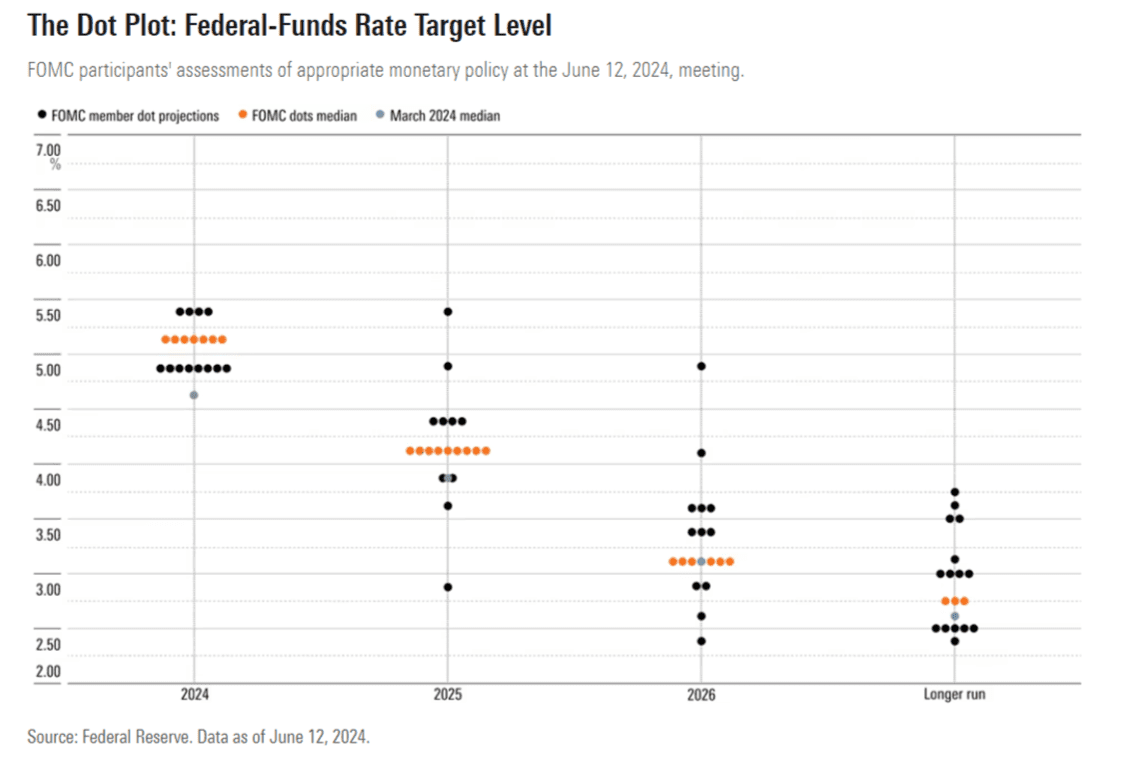

Markets were mixed for the week following a rate rally led by softer Consumer Price Index (CPI) numbers and a Fed decision to leave rates unchanged:
- The S&P 500 was up near-record levels for the week, gaining 1.58%
- The Dow Jones Industrial Average fell by 0.54%
- The Nasdaq Composite led major indices, going up by 3.24%
- The 10-year Treasury closed at 4.22%
At the beginning of the week, the latest CPI report showed that U.S. inflation fell to 3.3% in May from a year ago, slightly lower than the 3.4% economists had been expecting. Core CPI prices, which exclude food and energy, posted their smallest gains since the end of 2023 after rising 0.2% from the prior month. Additionally, the Producer Price Index (PPI) for the month of May posted a 0.2% decline, reinforcing the idea of easing inflation pressure.
Midway through the week, the Federal Open Market Committee (FOMC) stated that they are leaving their benchmark rate unchanged at 5.25%-5.5%. Furthermore, the central bank’s hawkish dot plot projected that it would cut interest rates just one time in 2024, leaving room for a few cuts in 2025.
Later in the week, the initial jobless claims measure rose to the highest it’s been since August 2023 at 242,000 claims filed, suggesting some softening in the labor market. Alternatively, the week’s U.S. Baker Hughes total rig count was released, measuring 590 rigs. This is now the second consecutive week where rig counts have been decreasing, depicting a possible new trend. Economists will be watching to see if this trend continues. Furthermore, weekly crude oil inventories were released, stipulating a weaker demand and providing consumers an insight into the possibility of a decrease in the price of oil.

Fed Speak Update
This past week saw the Fed’s June FOMC meeting and as expected, where rates remained unchanged for the seventh consecutive meeting. But more importantly, the Fed hawkishly changed their forecast for rate cuts for 2024 from three to one, indicating the Fed is comfortable leaving policy unchanged until it sees more evidence of either meaningful progress on inflation or notably softer labor markets.


The Fed kept rates unchanged despite inflation data published on Wednesday showing a decline in CPI in May from 3.4% to 3.3% year-over-year, with core CPI ticking downward and below the three-month rolling basis. More importantly, core services excluding housing (‘Supercore’ CPI, the Fed’s unofficially most-watched CPI indicator), fell by 0.04%, the first negative reading since September 2021. Despite this, the Fed’s concern of inflation reaccelerating has them cautious of cutting too early. Additionally, the Fed raised their long-term rate projections from 2.6% to 2.8%, with Fed Chair Jerome Powell stating, “Rates are less likely to go down to their pre-pandemic levels,” as well as an understanding that getting to a target 2% inflation may be unlikely in the long run, given long-term effects of demographics and the overall global economy.
Additionally, the effect of G7 peers, including the European Central Bank cutting rates, has not concerned the Fed as they stated, “We don’t see ourselves as having the confidence that would warrant beginning to loosen policy at this time.”
Despite the Fed’s commentary on only one cut for 2024, fixed income markets reacted significantly with the 10-year Treasury falling around 20 bps for the week to 4.22%, and with traders forecasting 45 bps in rate cuts for 2024 versus only 35 bps in rate cuts earlier in the week.

Due to the market holiday occurring midway through the week, the week will be relatively light on economic indicators. On Tuesday, retail sales for the month of May will be released, gauging the change in the total value of sales at the retail level, which is an important indicator of consumer spending and economic activity. Currently, economists are forecasting a 0.3% increase. That same day, business inventories for April will measure the change in the worth of unsold goods held by manufacturers, wholesalers, and retailers. Previous readings have shown trends of deprecation in unsold goods, indicating a healthy market.
Markets will be closed on Wednesday due to Juneteenth.
Rounding out the week, Markit will provide the manufacturing Purchasing Managers’ Index (PMI) and services PMI for the month of June, revealing the conditions of the manufacturing and service sectors. A reading above 50 suggests expansion, while a reading under 50 suggests contraction. Both industries have either met or exceeded reading expectations for the last three months. Furthermore, existing home sales for the month of May will be released, depicting the strength of the U.S. housing market.
This content was developed by Cambridge from sources believed to be reliable. This content is provided for informational purposes only and should not be construed or acted upon as individualized investment advice. It should not be considered a recommendation or solicitation. Information is subject to change. Any forward-looking statements are based on assumptions, may not materialize, and are subject to revision without notice. The information in this material is not intended as tax or legal advice.
Investing involves risk. Depending on the different types of investments there may be varying degrees of risk. Socially responsible investing does not guarantee any amount of success. Clients and prospective clients should be prepared to bear investment loss including loss of original principal. Indices mentioned are unmanaged and cannot be invested into directly. Past performance is not a guarantee of future results.
The Dow Jones Industrial Average (DJIA) is a price-weighted index composed of 30 widely traded blue-chip U.S. common stocks. The S&P 500 is a market-cap weighted index composed of the common stocks of 500 leading companies in leading industries of the U.S. economy. The NASDAQ Composite Index is a market-value weighted index of all common stocks listed on the NASDAQ stock exchange.
